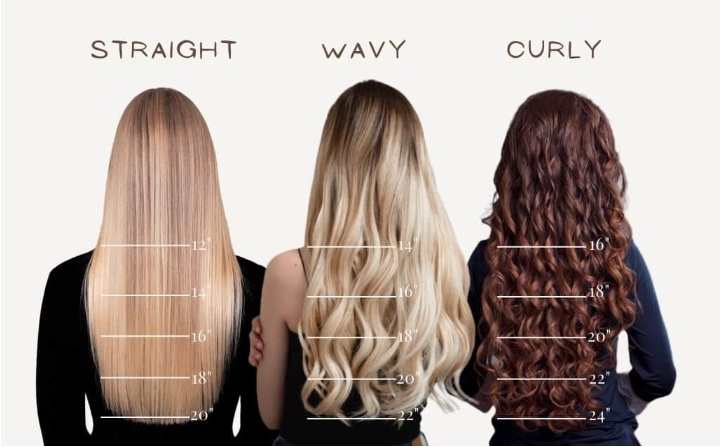Introduction to hair length charts
Are you tired of the same old hairstyle? Ready for a change but unsure how to decide on the perfect length? Enter the hair length chart—a handy tool that can help you visualize your options. Whether you’re contemplating a chic bob or dreaming of long, flowing locks, these charts can be incredibly useful. They provide insights into various lengths and styles, making it easier to communicate with your stylist. But are they right for everyone? Let’s explore what a hair length chart can offer and whether it fits into your hair care journey.
How to use a hair length chart
Using a hair length chart is straightforward and can be quite helpful. Start by measuring your hair from the crown of your head down to the tips. A flexible measuring tape works best for this task.
Next, find a reliable hair length chart online or in a beauty guide. These charts typically categorize lengths into sections: pixie, bob, shoulder-length, and beyond.
Compare your measurement to the chart’s categories. This gives you an idea of where you stand on the hair length spectrum.
Keep in mind that different styles may require specific lengths for optimal results. Whether you’re aiming for a chic bob or long flowing locks, knowing where you fall can aid in decision-making.
Remember that everyone’s hair behaves differently based on texture and health, so use these guidelines as just one part of your hairstyle journey.
Pros and cons of using a hair length chart
Using a hair length chart can be quite beneficial. It provides a clear visual guide, helping you understand different lengths and styles. This can simplify your conversations with hairstylists, ensuring everyone is on the same page.
However, it’s not without drawbacks. Hair texture and thickness play significant roles in how a style might look on you compared to the chart. What appears as shoulder-length on one person may hang differently due to these factors.
Additionally, relying too heavily on charts can stifle creativity. You might overlook unique hairstyles that don’t fit neatly into predefined categories.
While they serve as useful tools, it’s essential to balance their guidance with personal flair and individual characteristics for the best results.
Alternatives to hair length charts
If hair length charts aren’t your style, there are other ways to gauge hair lengths. One popular method is using reference images. Look for pictures of models or celebrities with similar hair types and textures. This visual comparison can provide a realistic idea of how certain lengths might look on you.
Another option is to use measuring tape or a ruler directly on your hair. Measure from the scalp down to get an accurate length without relying on charts.
You could also consider consulting with a professional stylist. They often have experience gauging what length works best based on your face shape and lifestyle.
Explore online forums or social media groups dedicated to hairstyling where you can seek advice and share experiences with others who understand the nuances of choosing the right hairstyle!
Factors to consider when choosing a hairstyle
Choosing the right hairstyle goes beyond just aesthetics. Your face shape plays a crucial role. Certain styles can enhance your features, while others might not be as flattering.
Hair texture is another important factor. Straight, wavy, or curly hair will react differently to various cuts and colors. Understanding your natural hair type helps in selecting a style that works with your locks instead of against them.
Lifestyle matters too. If you have a busy schedule, go for low-maintenance hairstyles that don’t require constant styling. On the other hand, if you love experimenting, consider more versatile options.
Think about your personal style and how much time you’re willing to dedicate to upkeep. A new haircut should reflect who you are and fit seamlessly into your daily routine without causing frustration or stress.
The importance of proper hair care
Proper hair care is crucial for maintaining healthy locks. Just like your skin, your hair requires attention and nourishment.
Using the right products tailored to your hair type can make a significant difference. Moisturizing shampoos and conditioners help retain essential oils, while serums can protect against damage from heat styling.
Regular trims are also vital. They prevent split ends and keep your hairstyle looking fresh. Even if you’re growing it out, those snips every few months will promote healthier growth.
Don’t forget about scalp health either; it’s the foundation of great hair. A clean scalp encourages strong follicles and reduces issues like dandruff or oiliness.
Hydration plays a key role too. Drinking enough water contributes to vibrant strands, making them less prone to breakage and dryness.
By prioritizing proper care routines, you ensure that your hair not only looks good but feels fantastic as well.
Conclusion
Choosing the right hairstyle can be an exciting journey, and a hair length chart can serve as a helpful tool along the way. These charts provide visual guidance that makes it easier to envision how different lengths will look on you. However, they are just one piece of the puzzle.
Consider your unique hair texture, face shape, and lifestyle when making decisions about your style. It’s essential to weigh the pros and cons of using a hair length chart while also exploring alternatives such as online virtual try-ons or consulting with professional stylists.
Don’t forget that proper hair care plays a critical role in achieving any hairstyle you desire. Healthy hair looks better at any length, so invest time into nurturing your strands.
Whether or not you choose to use a hair length chart should align with what feels best for you personally. Embrace the process and enjoy experimenting with styles that reflect who you are!




